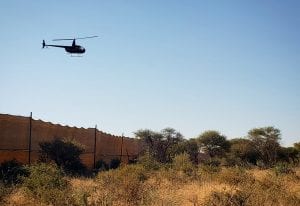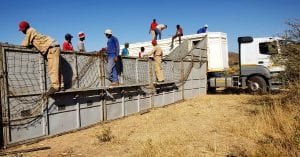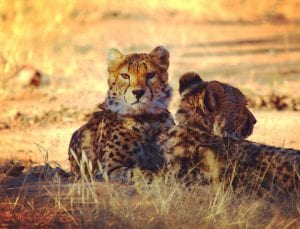 “This is a dangerous operation. Are you prepared for death?”
“This is a dangerous operation. Are you prepared for death?”
“Yes,” I nod foolishly.
The game manager delivered the signal on his walkie-talkie, and within moments I heard a helicopter approaching. I walked past a tall, tarp curtain, gingerly stepping over a series of taut ropes, and assumed my designated position. I concealed myself within the folds of the curtain, keeping part of my head exposed so I could still surveil the landscape, and awaited further instructions. Minutes later, a group of men were shouting and running frantically while tugging on the ropes, dragging one side of the curtain along the zipline. The voices quickly stopped, and the manager beckoned me to come forward, motioning to hide with him behind a tree. The helicopter suddenly arrived and started to descend. When it hovered directly above, it enshrouded us in a sandstorm cloud in which our key senses were temporarily disabled by the chalky dust and deafening whirr of the chopper blades. Once everything cleared, a female oryx appeared, looking less than thrilled. My next move was critical—it determined the success of the operation and my own survival.
There is never a dull day in the field of wildlife medicine. One of our principal duties consists of mastering the art and science of animal capture. Such tasks are necessary in order to relocate certain species for management purposes, exchange animals with other reserves or facilities, or temporarily isolate an animal in order to perform annual health exams or surgeries. Evidently, wild animals do not exhibit the same level of compliance one can achieve with domesticated pets. Veterinarians have various ways to conduct such captures; the choice of method depends largely on the type of animal being sought and what procedure is being performed. Chemical capture via darting is one of the more common techniques, in which remote drug delivery equipment is used to sedate an animal from a safe distance. However, an alternative and perhaps more adrenaline-packed method is the use of a boma.
 A boma is a large enclosure assembled with four solid walls that is traditionally used for livestock. The boma technique is sometimes preferred since it does not require chemical immobilization of the animal involved. However, this aspect is only suitable if the situation does not entail an intricate procedure or warrant major animal safety concerns. Additionally, if mass capture is the task at hand, bomas will usually be employed since it is not feasible to dart and sedate numerous animals at once within a limited timeframe. Bomas exist in several styles, but the ones constructed in the Okonjima Nature Reserve in Namibia consisted of tarp curtains strewn along a square wired perimeter. Some bomas can even be designed to attach to chutes, so as animals are guided into the boma, they continue to shuffle through the chute, from which they can load directly onto a livestock trailer. They can then be safely transported offsite without the added complications of having to sedate them.
A boma is a large enclosure assembled with four solid walls that is traditionally used for livestock. The boma technique is sometimes preferred since it does not require chemical immobilization of the animal involved. However, this aspect is only suitable if the situation does not entail an intricate procedure or warrant major animal safety concerns. Additionally, if mass capture is the task at hand, bomas will usually be employed since it is not feasible to dart and sedate numerous animals at once within a limited timeframe. Bomas exist in several styles, but the ones constructed in the Okonjima Nature Reserve in Namibia consisted of tarp curtains strewn along a square wired perimeter. Some bomas can even be designed to attach to chutes, so as animals are guided into the boma, they continue to shuffle through the chute, from which they can load directly onto a livestock trailer. They can then be safely transported offsite without the added complications of having to sedate them.
After a boma is erected, game managers must then condition the resident animals—mainly hoofstock—to enter the boma. By leaving the curtain open and placing feed troughs inside the boma, the animals grow more familiar with entering this intriguing structure to eat. Once the desired animal is located within the boma, the curtain is slid closed and the individual is passively “captured.” The boma operation at Okonjima, which relied on coordination between air pilots and a grounds team, utilized a helicopter in order to obtain an aerial whereabouts of the desired animals, then goad them into the boma from there. Some animals can be particularly savvy and seem to possess an uncanny ability to intuit what you are trying to coax them into; they either persistently stay just outside the perimeter or start moving in the opposite direction.
Accordingly, any boma operation entails the utmost strategic planning, precise timing, and quick reactivity. Even details boiling down to one’s outfit must be carefully considered. To avoid attracting the wariness of especially astute animals, all staff must wear colors that blend in with the surrounding terrain—hence, your classic tan/khaki safari color scheme.
As it was wintertime at Okonjima and we were undergoing a drought period, we realized grass was becoming scarce and wanted to relocate several animals to a different section of the reserve. Another rationale for conducting this high-stakes boma procedure was to address the overgrazing that had occurred. While browser animals (e.g. giraffe, oryx) were content to munch on high-growing vegetation like leaves and tree bark, the more numerous grazers (e.g. zebra, kudu) populating the area had completely foraged the limited grass available. Shifting a proportion of these browsers and especially grazers to a different, unused patch of land would not only give them access to a more abundant food supply, but also enable the grass to regrow at the original site.
 After briefly corralling the surly oryx and getting notified that all curtains had been slid closed, our next task was simply to get out of the enclosure. I then calmly and quickly sneaked past the curtains to escape an interior now teeming with rambunctious hoofstock, then continued to run a couple meters further before I finally relaxed. The reason behind my exit strategy: a still-fuming oryx could continue to charge at the barrier with its famously long, straight horns and impale an unsuspecting person leaning on the other side.
After briefly corralling the surly oryx and getting notified that all curtains had been slid closed, our next task was simply to get out of the enclosure. I then calmly and quickly sneaked past the curtains to escape an interior now teeming with rambunctious hoofstock, then continued to run a couple meters further before I finally relaxed. The reason behind my exit strategy: a still-fuming oryx could continue to charge at the barrier with its famously long, straight horns and impale an unsuspecting person leaning on the other side.
This post is written by Elvina Yau and was originally published on her WordPress blog, Elvina the Explorer, on September 2, 2018.
ABOUT THE AUTHOR:
 Elvina Yau, class of 2020, is a veterinary student from Long Island, New York. She graduated from the University of Pennsylvania in 2016 with a degree in Behavioral Neuroscience and double minor in Creative Writing & Biology. Elvina aspires to split her time between practicing Companion Animal Medicine in the U.S. and contributing to conservation efforts abroad both as a clinician and freelance photojournalist.
Elvina Yau, class of 2020, is a veterinary student from Long Island, New York. She graduated from the University of Pennsylvania in 2016 with a degree in Behavioral Neuroscience and double minor in Creative Writing & Biology. Elvina aspires to split her time between practicing Companion Animal Medicine in the U.S. and contributing to conservation efforts abroad both as a clinician and freelance photojournalist.
